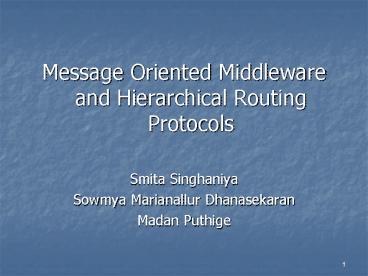Message Oriented Middleware and Hierarchical Routing Protocols - PowerPoint PPT Presentation
1 / 32
Title:
Message Oriented Middleware and Hierarchical Routing Protocols
Description:
publishes ('sender') and subscribers ('receivers') applications. asynchronous communication ... Minimizes distance non-leader nodes must transmit ... – PowerPoint PPT presentation
Number of Views:367
Avg rating:3.0/5.0
Title: Message Oriented Middleware and Hierarchical Routing Protocols
1
- Message Oriented Middleware and Hierarchical
Routing Protocols - Smita Singhaniya
- Sowmya Marianallur Dhanasekaran
- Madan Puthige
2
Wireless Sensor Networks
- increasing development of wireless sensor
networks (WSNs) - scarce resources (memory, battery, processing
capacity) - thousand of nodes
- event-driven
- traditional middleware systems are heavyweight
- request/reply communication is not adequate
3
WSN Scenario
4
Message Oriented Middleware
- MIRES Middleware for WSNs
- enables communication between sensing-based
applications - provides a set of middleware services
- hides the complexity of communication underlying
mechanisms from the sensing-based applications
5
MIRES Basic Facts
- message-oriented middleware
- publish/subscribe service
- asynchronous communication
- encapsulates network-level protocols
- routing and topology control protocols
- aggregation service
- collects and integrates data generated from a
large and physically dispersed set of nodes - API (Application Programming Interface)
6
MIRES Architecture
7
MIRES Publish/Subscribe Service
- a publish/subscribe middleware
- publishes (sender) and subscribers
(receivers) applications - asynchronous communication
- sender and receiver may not be present in the
network at the same time - topics (subject)
Sender
Receiver
MOM
Queue
Operating System
Hardware
8
MIRES Publish/Subscribe Service
- allows the communication between middleware
services - responsible for advertises topics
- maintains the list of topics subscribed by the
node application - publishes messages containing data related to the
advertised topics
Node Application
Node Application
MIRES
Aggregation Service
Routing
ServiceN
Routing
Service
Service
1
N
Publish/subscribe service
Operating System
Sensors
CPU
Radio
9
MIRES Publish/Subscribe Service
- TinyOS
- nesC language
- component-based programming model
- each component provides and uses services
- components interface is made up of commands
(procedures)
10
MIRES Publish/Subscribe Service
- publish/subscribe service -gt other components
- Node application advertises its ability of
sensing data related to a topic - the publish/subscribe services sends that
information to the network
sink node
user application
11
MIRES Publish/Subscribe Service
- message arrival from the network
- all messages are addressed to the sink node
- MultiRouter signalises an intercept an event
- the publish/subscribe service updates its
internal control - the publish/subscribe services returns an
indication that the message can be forwarded
sink node
user application
12
MIRES Publish/Subscribe Service
- topic subscription
- user application broadcasts subscribed topics to
the network - BCast signals a receive event
- the publish/subscribe service notifies services
attached to it
sensor nodes
sink node
user application
13
MIRES Publish/Subscribe Service
sensor nodes
sink node
user application
14
MIRES Aggregation Service
- the aggregation of data collected from sensors
reduces the number of transmissions - performed in each node
- configuration parameters
- aggregation function (e.g., suppression, min,
max, average) - stop criteria
15
MIRES Aggregation Service
16
MIRES Routing
- Multi-hop routing algorithm
- Clustering-based Hierarchical Routing Protocols
17
Hierarchical Protocol
- Multi hop communication with network clustering
- Data Aggregation and Fusion
- LEACH
- PEGASIS
- TEEN and APTEEN
18
Low-Energy Adaptive Clustering Hierarchy
- Cluster head for the current round if the random
number is less than the following threshold - p is the desired percentage of cluster heads
- r is the current round
- G is the set of nodes that have not been cluster
heads in the last 1/p rounds
19
Low-Energy Adaptive Clustering Hierarchy
Cluster Heads at time t
Cluster Heads at time t d
20
Drawbacks of LEACH
- Single-hop routing each node transmits directly
to the cluster-head and cluster-head directly to
the sink - Dynamic clustering extra overhead
21
Power-Efficient Gathering in Sensor Information
System PEGASIS
- Eliminates dynamic cluster formation
- Minimizes distance non-leader nodes must transmit
- Limits the no. of transmissions and receptions
among all nodes - Only one transmission to the BS per round
22
Chaining in PEGASIS
C0,C1,C3,C4 - Non-leader nodes C2- Leader Node
- Each node communicates only with the closest
neighbor - Gathered data moves from node to node, get
fused and
sent to the
BS by the designated leader node - Nodes take turns being the leader ( I mod N)
- Chaining is done using the greedy approach
- When a node dies chaining is done again
23
Hierarchical PEGASIS with CDMA
- Constructs a chain of nodes, that forms a tree
like hierarchy - Data transmitting in parallel
- Tree is balanced, the delay will be in
- O (log N)
24
- Nodes at even positions transmit data to their
right - Nodes receiving at each level rise to next
level in hierarchy
25
Comparison of PEGASIS with LEACH
- PEGASIS has been shown to outperform LEACH by
about 100 to 300 for different network sizes and
topologies
26
Threshold sensitive Energy Efficient sensor
Network protocol
27
Threshold sensitive Energy Efficient sensor
Network protocol
- Responsive to sudden changes in the sensed
attributes such as temperature - Cluster head broadcasts to the nodes
- Attributes
- Hard threshold
- Soft threshold.
- TEEN is not good for applications where periodic
reports are needed
28
Adaptive Threshold sensitive Energy Efficient
sensor Network protocol
- Captures both periodic data and reacts to
time-critical events - Historical, to analyze past data values
- one-time, to take a snapshot view of the network
- Persistent, to monitor an event for a period of
time
29
Threshold sensitive Energy Efficient sensor
Network protocol
- Time line for the operation of TEEN and APTEEN
30
Drawbacks of TEEN and APTEEN
- Overhead and complexity of forming clusters in
multiple levels - Implementing threshold-based functions
- Dealing with attribute-based naming of queries
31
Conclusion
- publish/subscribe paradigm asynchronous
communication model - multi-hop routing algorithm hierarchical
routing algorithm
32
Questions ????
- Thank You































